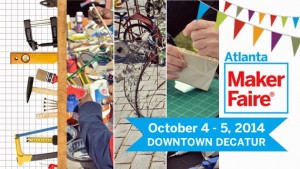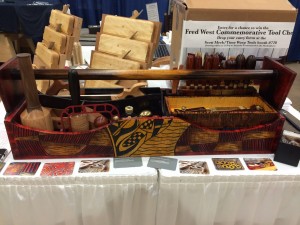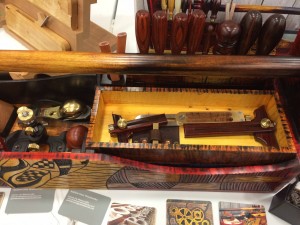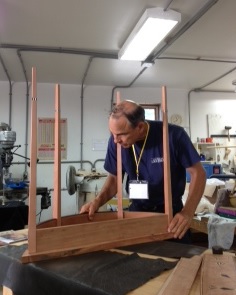“If you’re woodworking and it doesn’t sound like music, you’re not doing it right”-Roy Underhill
Woodworking in America is well-known for its excellent Marketplace, which we covered in several posts last week (here, here and here, for example). But the conference is also known for the fantastic classes offered by excellent instructors. Excellent instructors who you can then walk up to at the end of the class and personally ask that woodworking question that has been keeping you up at night. For most woodworkers, this is the opportunity of a lifetime.
With so many classes offered in the two days, we weren’t able to attend all of them. But between the pictures, quotes, nuggets of useful woodworking information and videos below, hopefully you can get a taste of how great it was. And when Popular Woodworking announces the dates for Woodworking in America 2015 (any day now, according to editor Megan Fitzpatrick…) make sure you put it on the calendar and buy your tickets so you won’t miss out!
—–

Class: Windsor Innovations
Instructor: Peter Galbert
Peter Galbert started his chair making passion when living in New York City and made chairs in a 5th floor walk-up apartment. The standard makeup of his chairs includes: A soft wooden seat, turned legs, and a split wood top, which allows for exceptional strength and bend-ability. Instead of sand paper, he uses scrapers when finishing his seats, which gives it a better look in the end.
Funny Peter Galbert quotes:
“My materials are inexpensive compared to what I turn them into.”
“Forgive me for going down a woodworking nerd rabbit hole…but here we go.” (Discussing the design of his shave horse).
-”Turn the burr- one of the worst phrases in woodworking.”
—–
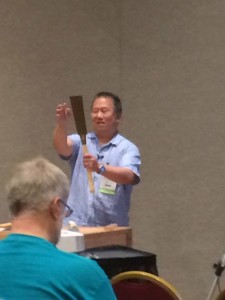

Class: Japanese Chisels and Japanese Saws for the Western Woodworker
Instructor: Wilbur Pan
In this class Wilbur showed off several different Japanese saws and chisels and described their uses.
He explained the differences between a Kataba saw and a Ryoba saw (apparently the Ryoba isn’t necessarily a bargain just because it is two saws for the price of one), as well as the how the small details in the design of the Maebiki saw made it ideal for milling down logs.
Wilbur also gave a great explanation for why Japanese saws are able to be made so thinly, and will still cut straight. (Hint – it is all about the pull-stroke!)
—–
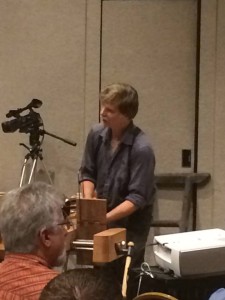
Class: Making the Roubo Bookstand
Instructor: Roy Underhill
In this class, Roy went through the step-by-step process of creating the Roubo Bookstand from just one solid piece of air-dried Walnut. In Roy’s typical fashion, there were some very funny moments wrapped up with a lot of very useful woodworking knowledge. Our favorite part was when Roy explained the only way he has ever been described as “boring”. (Every other time, he was drilling!)
—–
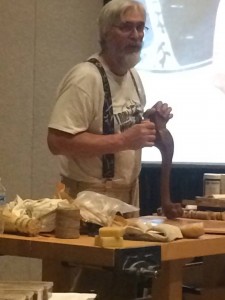
Class: Secrets of Period Finishing
Instructor: Don Williams
Throughout the centuries there have been a wide variety of finishes based on the materials that were available during that time period. Don showed us a variety of these finishes and techniques, and how we can “apply” them in our shops today! He taught us that finishing is a period of steps where you’re not messing up what you did before. At one point in the class, someone in the audience said he was amazed the planing Don was doing wasn’t tearing up the wood, and Don invited him up to give it a try. In general he was very open to audience discussion and participation in the class.
Class quote: “Every time you make a pot roast, you are starting a woodworking project whether you know it or not!”- Don Williams explaining hide glue production.
—–

A very early issue of Popular Woodworking
Class: How the Sausage Gets Made and How You Can be a Part of it
Instructor: Megan Fitzpatrick
Megan Fitzpatrick gave an informative and at times hilarious presentation on the history of Popular Woodworking and the process she goes through to produce each issue. Let’s just say we will never take for granted an issue of Popular Woodworking again! One of our favorite moments from the class (and there were a lot of favorite moments) was Megan telling us about the first issue she edited, and all the red ink she wasted ‘correcting’ all of the mentions of ‘rabbets’ and ‘moulding’. She certainly learned what those words meant by the next issue!
—–
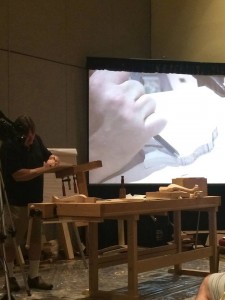
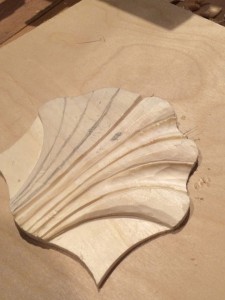
Class: Shells, Shells and More Shells
Instructor: Chuck Bender
Chuck taught the process of carving shells for period furniture, including designing the patterns and the actual carving itself. He started with a piece of Basswood, which is a good starter wood for carving. When removing the waste from the shell projects, he uses a V-parting tool. He believes that if you’re not making chips of some sort during this process, then you’re not doing much of anything. As you continue carving the shape, you want to turn the carving upside down and you’ll see shapes and bumps that you hadn’t seen before. A helpful tip he taught was that when carving, you use both of your hands and if you’re right handed then that is the “gas” and the left hand is the “brakes.”
—–
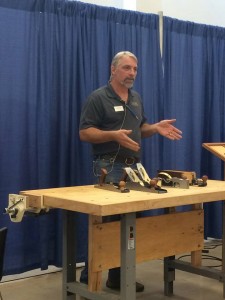
Class: Understanding the Core Hand Tools
Instructor: Deneb Puchalski
Deneb taught us that you should have a basic set of 3 different hand planes for the 3 different types of board cuts you need to make: roughing, flattening, and finishing. For these 3 cuts you need a Jack Plane (rough, coarse, heavy work), a Jointer Plane (interacts with the high points of the board), and a Smoother Plane (makes short, fine cuts). With these three basic planes you can make any kind of cut to complete your project. “Hand tools teach you how to be a better woodworker”-Deneb Puchalski
—–
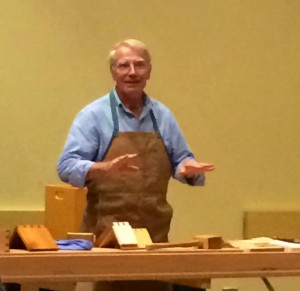
Class: Frank’s Favorite Joints
Instructor: Frank Klausz
It would be sacrilege to attend WIA and not enjoy the sight of Frank Klausz cutting a smooth and simple dovetail joint. And that is exactly what he started with in this class. Talking the whole while and mixing semi-brilliant woodworking commentary with random thoughts, we came away with the following useful nuggets of information and perspective:
“A key question to ask when building furniture – what type of joint goes where?”
“We aren’t cabinetmakers, we are box-ologists.”
“Learn to cut dovetails on a piece of paper. Handwork has character – the angles will be different, the tail size will be different. Just make the dovetails a size that pleases you.”
“If it is too tight, don’t force it, just get a bigger hammer.”
—–
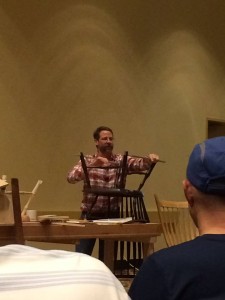
Class: Rocking Chairs
Instructor: Peter Galbert
On the second day of WIA, Peter Galbert was up early to teach an 8:30 class on Rocking Chairs. He pulled the rockers off of a chair he had never been satisfied with and used it as an opportunity to demonstrate to the class how he would go about balancing a new set of rockers and aligning them so the chair feels right to the individual sitter.
On mistakes being the best way to learn: “You should see me teach turning. All I do is show you how to screw up.”
—–

Class: Carving Tools for Green Work
Instructor: Drew Langsner
Drew Langsner, also dressed in the apparent presenter uniform of suspenders, used large single ply models of tool edges to demonstrate the best way to sharpen your carving tools for green work. He stated an interesting theory towards the beginning of class that he referred back to a few times throughout the class:
“Woodworking is the interaction of animal, vegetable and mineral. We are the animal, wood the vegetable and the tool is the mineral. Simplifying it to that level will help you solve a lot of woodworking problems.”
And his reasoning for using the large single ply models to demonstrate?
“Putting a hollow on a very small tool is devilishly difficult.”
—–
Thanks to Matt Vanderlist, we were able to get video coverage of several more classes in our Woodworking in America Montage, Parts 1 and 2 below:
Part 1: Roy Underhill’s Combination Planes, Glen Huey’s Add “Wow!” to Your Projects with Inlay, and Frank Klausz’s Table Saw Jigs
Part 2: W. Patrick Edward’s Building and Using a Chevalet and Wilbur Pan’s Japanese Saws for the Western Woodworker.

